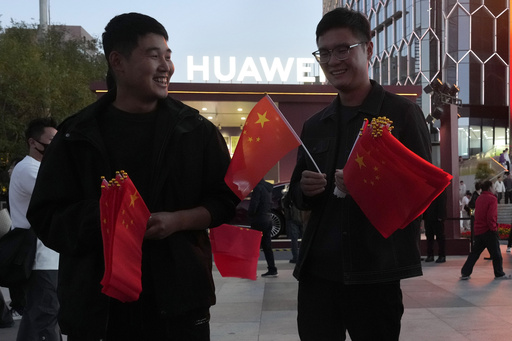TAIPEI, Taiwan — On Monday, China implemented reciprocal tariffs on imports from the United States, coinciding closely with U.S. President Donald Trump’s announcement to impose new tariffs on all steel and aluminum imports into the United States.
This swift exchange of tariffs echoes the contentious trade relationship that characterized Trump’s administration, as well as the continued tensions in trade policy under President Joe Biden.
Less than a month after Trump’s return to the presidency on January 20, he instigated a 10% tariff on all goods coming from China, a decision poised to increase retail prices on various products ranging from electronics to fashion items.
In retaliation, China enacted a 15% tariff on coal and liquefied natural gas imports, along with a 10% tax on crude oil, agricultural machinery, and larger vehicles imported from the U.S.
Furthermore, the Chinese government initiated an investigation into Google’s monopolistic practices and placed PVH, owner of the popular U.S. brands Tommy Hilfiger and Calvin Klein, onto its “unreliable entity” list. This, along with restrictions on the export of five critical rare metals essential for the defense and renewable energy sectors, signifies an escalation in tensions.
As these recent developments highlight the potential for a renewed trade war, here’s a brief overview of significant milestones in the protracted trade conflict between the two nations:
March 2017 saw Trump, shortly after taking office, issue an executive order aimed at enhancing tariff enforcement against dumping practices.
By April 2017, Trump and Chinese President Xi Jinping had agreed to a 100-day plan to address trade issues, which ultimately failed by July of that year.
In August 2017, Trump commenced an investigation into purported theft of U.S. intellectual property by China, with estimates suggesting losses of up to $600 billion annually for the U.S.
In January 2018, the U.S. instituted a 30% tariff on imported solar panels primarily sourced from China.
By April 2018, China responded with tariffs on U.S. imports valued at about $3 billion, levying a 15% tax on various goods, including fruits and nuts, and a 25% duty on pork and aluminum. Shortly after, the U.S. retaliated by imposing a 25% tax on about $50 billion of Chinese goods, to which China responded with equivalent tariffs on U.S. exports, including soybeans and automobiles.
From June to August 2018, both countries engaged in at least three more rounds of tariffs impacting over $250 billion in Chinese goods and more than $110 billion in imports from the U.S.
Between December 2018 and May 2019, efforts to finalize a trade agreement faltered after initial consensus to pause new tariffs, resulting in Trump increasing tariffs on $200 billion of Chinese imports from 10% to 25%.
In May 2019, Huawei, a Chinese tech firm, was banned from procuring U.S. components, and by June of the same year, Trump and Xi sought to resume trade discussions, which encountered various delays over the subsequent months.
The signing of a Phase One trade deal in January 2020 outlined China’s commitment to purchasing an additional $200 billion in U.S. goods over two years, although studies later indicated China had not fulfilled these purchase commitments.
In October 2022, Biden continued many of Trump’s tariffs and imposed comprehensive restrictions on semiconductor sales to China, with further extensions slated for late 2023 and into 2024.
In February 2024, Trump announced plans to impose tariffs of at least 60% on all Chinese imports if re-elected, while in May 2024, Biden increased duties on tariffs related to electric vehicles and other products from China.
Come February 4, 2025, new 10% tariffs on all imports from China will be enacted, prompting China to announce its own series of counter-tariffs on U.S. coal, liquefied natural gas, and agricultural machinery on the same day.




